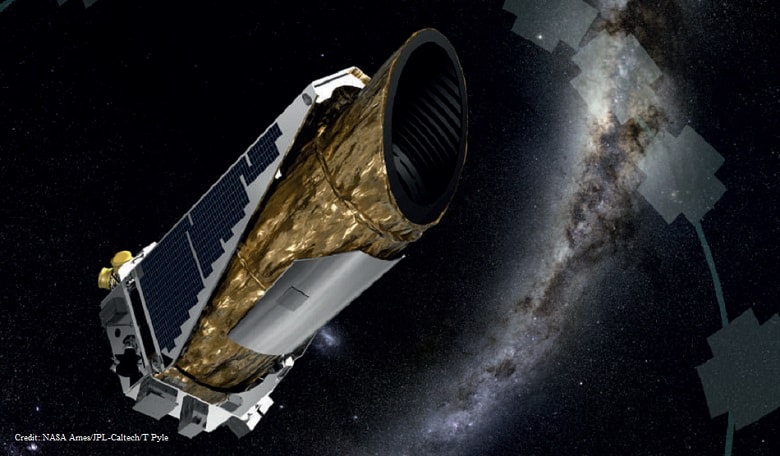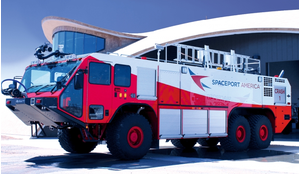In July 2015, a team from NASA’s Kepler mission took the world by storm when it announced Kepler-452b. According to the official statement, the planet was Earth’s bigger, older cousin. It was just 1.6 times larger than Earth and was in a similar orbit to Earth around a similar star to the Sun. Soon it was being talked about as the nearest thing we know to a twin planet for Earth. Finding this tantalising world was by no means an overnight success. The Kepler mission has been a labour of love, and a fight against the odds, for more than 20 years.
On 10 May 2014, my lead scientific programmer, Joe Twicken, sent me an e-mail. It said that he was reviewing the results of a test run of new analysis software and it had identified a planet that was 1.1 Earth radii, and clearly in the habitable zone of what appeared to be a G-type star, the term for a star like the Sun. It was exactly the kind of planet and star combination that we had hoped Kepler would find, but which had eluded the mission until this point. It was an exciting, thrilling, but also terrifying time.
Early on we had a moment of pause, because when we first looked at the star’s parameters, although it was about the same temperature as the Sun, it had been assigned a radius of only 80% the size of the Sun. That seemed a little off to us. It’s quite unexpected to have a star as hot as the Sun but significantly smaller. You would expect the star’s size to be much closer to that of the Sun.
So I contacted several astronomers I know to do follow-up observations, using relatively small to mid-size telescopes to take spectra of the star to get a better idea of its stellar parameters. The first spectroscopic follow up observations were made at McDonald Observatory, and the results are a bit disappointing. The initial analysis indicated that the star could be as much as 20- 25% larger than the Sun, and that would have taken this planet up to 1.8 Earth radii. At that size we believe there is a good chance that such a planet would not be rocky.
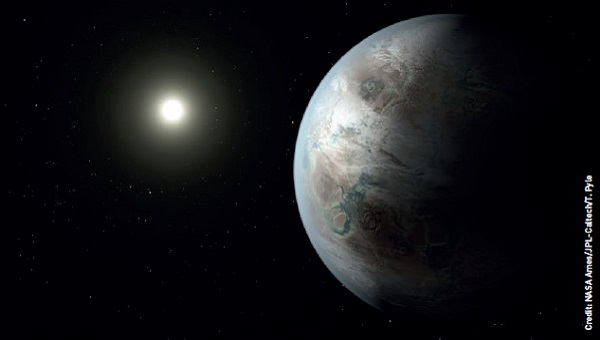 This artist’s impression depicts one possible appearance of the planet Kepler-452b, the first near-Earth-size world to be found in the habitable zone of a star that is similar to our Sun.
This artist’s impression depicts one possible appearance of the planet Kepler-452b, the first near-Earth-size world to be found in the habitable zone of a star that is similar to our Sun.
The prize, of course, was to find something that really looked like Earth - a rocky world in a one-year orbit around a Sun-like star. Rather than just give up, we thought, “Well, let’s get another measurement.”
We obtained additional spectra using the Fred L. Whipple Observatory in June 2014 and the results were much more exciting. They indicated that the star was only 5% larger than the Sun. That brought the planet down to 1.5 Earth radii. It still wasn’t as small as the original estimate but if you get down below 1.5 Earth radii then the chances that it’s rocky are much higher.
…in January 2013 the incidence of these friction events increased, and it was clear that reaction wheel 4 was on its way out.
So we pressed forward with the work to validate this as a planetary discovery. Kepler does not see planets directly. Instead, the analysis software infers their presence by looking for the drop in starlight when a planet crosses the face of its star and blocks out some of the light. So we had to check that we were not being fooled by something that just looked like one of these planetary transits.
We wanted to look in the neighbourhood of the star, to make sure there wasn’t a dim background star system contaminating the signal. So we made high resolution adaptive optics observations at the Keck Telescope on Mauna Kea, Hawaii. We knew that an eclipsing binary or a star with a giant transiting planet could combine with the foreground star’s light to cause a transit-like feature. He got back to me relatively quickly and said it’s completely clean. He said there’s no evidence in the high resolution image data for any background object.
To validate this discovery statistically we then applied an analysis package called Blender, that basically looks at all possible configurations of hierarchical star systems and calculates the probability that they could be responsible for the signal. We were able to exclude those possibilities, so that the confidence in the planetary nature of this object was estimated at 99.76%. That’s high enough for us to consider it to be statistically validated.
We put the paper together and submitted it. It’s a very long process. You expend years and years and years of effort, and the signature pops out suddenly, and then it’s a hurry up and wait situation, because you have to schedule follow up observations and do the analysis. It took from May 2014 to October to finish the validation. Then we took several months to put it together as a paper.
The hardest question was whether this is the most Earth-like planet we’ve found to date.
The hardest question was whether this is the most Earth-like planet we’ve found to date. In many respects it is but, at about 1.6 earth radii, it’s no Earth twin. Even if it were 1.0 Earth radii, we wouldn’t know whether it has or had an ocean and continents with plate tectonics, or has simple or complex life.
So we really can’t tell whether this or, indeed, any other exoplanet discovered to date is really “earth-like” in the sense of having plant and animal life. That’s for future astronomers, scientists and engineers to work on. But we can be very happy indeed that we’ve answered the question of whether there are other small worlds out there orbiting in the habitable zone of other stars, and indeed, there will be billions.
From the sidelines to centre stage
This was the first major paper tha t I’ve led as the first author, and being in the pr ess conference itself was a new experience. Previously, I’ve cheered from the sidelines for most of the Kepler mission’s major press announcements. My role for the last 20 years has been to develop, design, and implement the science pipeline, which finds the transit signals. Our science principal investigator, Bill Borucki, has put in three decades.
I joined at a time when this mission was only a proposal concept. We spent the first six years or so simply doing lab-based demos to prove that we could actually achieve the photometric precision necessary with our instruments and our CCDs to find these very small planets orbiting these very large stars.
And the precision we’re looking for is typically just 20 parts per million, or one percent of a percent, and that is extremely difficult to achieve. From the ground you can achieve something like one part per thousand, so we’re talking about orders of magnitude of improvement with Kepler.
It took a huge amount of effort to convince our colleagues in the astronomical community that Kepler was actually feasible. And then it was hard to build everything and launch it in 2009. And even when we launched, there were skeptics predicting that we would find eclipsing binary stars but very few planets.
What has surprised all of us is the huge incidence of compact multiple planet systems. Nobody predicted when we launched that we would have something like Kepler-11, with five planets and most of them in orbits smaller than the orbit of Mercury and the outermost of which would fall within the orbit of Venus. And Kepler 186f which was announced in April 2014: a 1.2 Earth radius planet in the habitable zone of a small star only about half the size and mass of the Sun. All of the planets in that system, including Kepler 186f, which is the outermost one, fall within the orbit of Mercury.
So we’ve been quite astounded with how many planets there are, especially planets in these multiple systems. This tells us that nature loves to build planetary systems and that there are processes within these planetary systems that force the planets to migrate inwards. Many of these systems are dynamically-packed. If you try to push the planets closer into their star, and closer together, they would not be dynamically stable.
Our solar system appears to be an oddball in the sense that the planets are quite spread out, but part of that is because it’s very difficult to detect all of the planets in a system like our own. It would take many, many years and fortuitous alignment of all the orbits. So we have to understand where our own solar system sits in the context of everything else. The truth is that none of the methodologies we have to find planets would allow us with great certainty to find other solar systems exactly like our own.
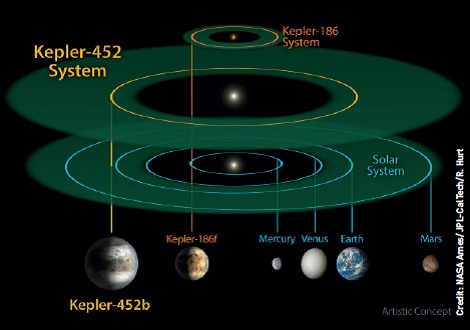 This size and scale of the Kepler-452 system compared alongside the Kepler-186 system and the solar system. Kepler-186 is a miniature solar system that would fit entirely inside the orbit of Mercury. The habitable zone of Kepler-186 is very small compared to that of Kepler-452 or the sun because it is a much smaller, cooler star. The size and extent of the habitable zone of Kepler-452 is nearly the same as that of the sun, but is slightly bigger because Kepler-452 is somewhat older, bigger and brighter. The size of the orbit of Kepler-452b is nearly the same as that of the Earth at 1.05 AU. Kepler-452b orbits its star once every 385 days.
This size and scale of the Kepler-452 system compared alongside the Kepler-186 system and the solar system. Kepler-186 is a miniature solar system that would fit entirely inside the orbit of Mercury. The habitable zone of Kepler-186 is very small compared to that of Kepler-452 or the sun because it is a much smaller, cooler star. The size and extent of the habitable zone of Kepler-452 is nearly the same as that of the sun, but is slightly bigger because Kepler-452 is somewhat older, bigger and brighter. The size of the orbit of Kepler-452b is nearly the same as that of the Earth at 1.05 AU. Kepler-452b orbits its star once every 385 days.
Nevertheless, what makes Kepler-452b so charming is that it’s the closest analogue we have to the Sun-Earth System. It has a star that has essentially the same surface temperature as the Sun, but with just 4% more mass. Nevertheless, it is still another G2-type star. Around it is a small planet that has a good chance of being rocky, and orbits at about the same distance that Earth is from the Sun, so receives essentially the same amount of radiation. That’s what makes this so exciting. It’s the closest analogue we have.
Rocky path to rocky planets
No one expected the discovery of Earth-sized worlds to be easy but it has proved even more challenging than first thought. A few years into the mission, after we’d been working very hard on the pipeline to better accommodate instrumental noise, we seemed to be hitting a limit. Ron Gilliland led a paper analysing the Kepler data.
What that showed was that G-type stars appear to be twice as variable as the Sun. That was a very sobering moment in the history of Kepler because such variability made picking out the transit signals harder. It did not mean that hope was lost but it implied that we had to collect more data, and double down to work much harder to identify and remove instrumental systematics because we could obviously do nothing to stop the variability of the stars.
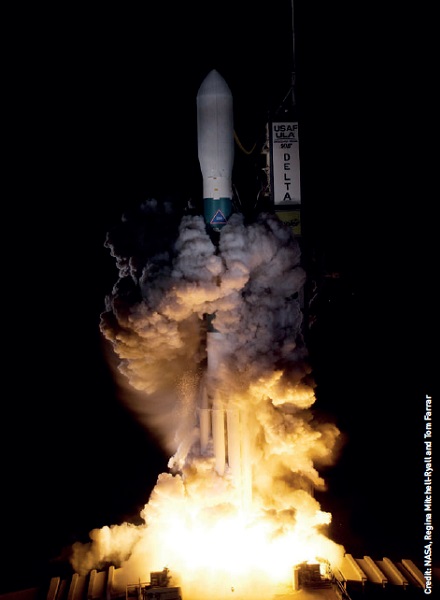 The Delta II rocket carrying NASA’s Kepler spacecraft blasts off from Launch Pad 17-B at Cape Canaveral Air Force Station in Florida at 10:49 p.m. EST on 6 March 2009.
The Delta II rocket carrying NASA’s Kepler spacecraft blasts off from Launch Pad 17-B at Cape Canaveral Air Force Station in Florida at 10:49 p.m. EST on 6 March 2009.
Ron’s analysis demonstrated that we needed to collect a lot more data in order to recover the expected sensitivity of the original proposed mission. We were funded for three and a half years, and we believed that we needed something like 7-8 years of data. That was actually quite promising at the time.
We submitted a proposal to request an extended mission, based on the progress we had made improving our pipeline and sensitivity, along with this analysis that showed that the fault was in the stars, not in ourselves! NASA secured the funding and extended us.
The next shoe to drop came in June 2012 with the loss of a reaction wheel on the spacecraft. We were expecting it to fail at some point during the mission because when we were in the development phase we learned that the Time-D mission, which had used the exact same make and model of reaction wheels, had experienced a failure early in its mission. A tiger team formed by NASA was still trying to figure out exactly what was going on with these wheels, because they fit a very important niche with respect to the pointing precision that they could give a spacecraft.
Despite the uncertainty, we had no other choice but to use them on Kepler. If we used larger wheels, we would get more rumble and that would break our pointing requirements. Kepler was stuck with these wheels, and so we made the most of the situation. The engineering team did take them apart, inspected the bearings, made some adjustments, put them back together, and made recommendations with respect to how they should be transported, because the theory at the time was that some of the damage was resulting from a latching mechanism that was engaged while the wheels were not spinning but transported on the ground.
Then we launched and held our breath. Everything was fine until 2012 when we lost the first wheel out of four. The good news was that we needed only three to keep going but the loss spurred investigations. The engineers took a very close look at all the engineering data that had been downlinked, and brought down even more to work with. They found that reaction wheel 2, which was the first one to fail, had started acting up early in the mission.
They saw that reaction wheel 4 was also acting up. It had these spurious events where you got a sudden increase of friction in the bearing before it went back to being kind of normal. Every 90 days, to keep the solar arrays pointing at the Sun, we rotated the spacecraft by 90 degrees. During these manoeuvres, the wheels would often start spinning in the reverse direction. In the weeks leading up to one of these rotations, we would see these strange friction events begin to take place, but when we turned the spacecraft and the wheels started to spin in the other direction, the behaviour seemed to stop. It was as if the wheel was resetting itself. So we hoped that this was just ‘normal behaviour’ for reaction wheel 4.
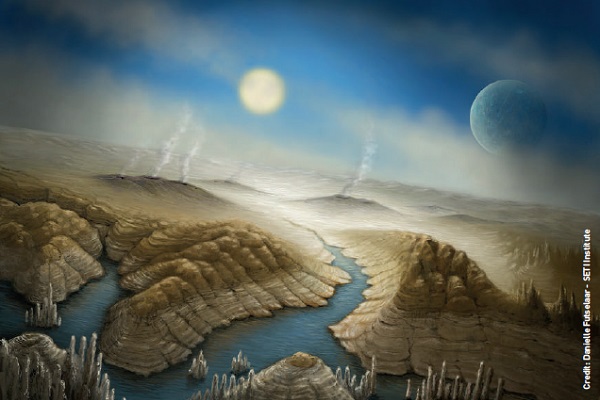 An artist’s impression of the surface of Kepler-452b. With a radius 60% larger than Earth, the planet has a better than even chance of having a rocky composition, and is likely to have a thick atmosphere and a significant amount of water.
An artist’s impression of the surface of Kepler-452b. With a radius 60% larger than Earth, the planet has a better than even chance of having a rocky composition, and is likely to have a thick atmosphere and a significant amount of water.
But in January 2013 the incidence of these friction events increased, and it was clear that reaction wheel 4 was on its way out. In May, we decided to rest the wheel for 10 days, hoping that some of the lubricant would migrate back into the raceway and help out. But when we brought the wheel back online, we only got a week’s worth more data before it finally died.
That was a crushing event. But as I told the science principal investigator the day it died, we originally asked for a four-year mission and that’s exactly what we got. He chuckled and said that he was delighted with the way the mission had gone. Given the choices we had to make, we did the best that we could.
We were unable to collect 7-8 years of data and that means our sensitivity is not as high as we would like to find Earth-sized planets in the habitable zones of Sun-like stars. And that’s part of why Kepler-452b is a real triumph of technology & human will in a struggle against very high odds.
Improving the pipeline
With no new data coming in, the only thing we could do was improve our analysis pipeline. Much of the last couple of years has been spent on the instrumental effects, trying to tamp those down while retaining sensitivity to find small planetary signatures.
It’s been a huge effort by a large team – scientists, scientific programmers, and computer scientists, and the operations folks who run the pipeline. They have to assist us to test each pipeline. It’s a large job.
When we run the pipeline, we have something like 20,000 transit-like features coming out.
We have 7 scientific programmers, 5 software engineers, 4 operators, and all of the development staff up until recently have been working on their own piece of the pipeline. That’s a lot of code. In fact the code base has a million lines of code. Probably 150 person years of effort for the Kepler code base. It’s a large engineering enterprise and cutting edge research.
It has been a huge effort on many levels, from the front end of the pipeline to the back end of the pipeline, a huge human effort. When we run the pipeline, we have something like 20,000 transitlike features coming out. And we have 5-6000 features that are consistent with being planets but only a small fraction of the original 20,000 transitlike features are real.
It takes a lot of computational power. That’s why we moved our entire science pipeline to the NAS Pleiades supercomputers. So as we’ve improved our pipeline and improved our sensitivity to small planets we can regularly reprocess all the data. We can only do that in a reasonable amount of time if we’re using a supercomputer.
The last time we ran the pipeline was in September of 2014. And indeed we’ve been working for the last year and a half or so on a newer version of the pipeline – what we call SOC, Science Operations Center 9.3. This is the final version of the planet search pipeline.
Even if you assume that Earth-like planets are common, they remain very difficult to detect.
We’re about ready to start our transit search portion of it. We’ve completed the front end processing to construct the light curves, to identify systematic errors/instrumental effects from the data, and we’re about to search through all these light curves. We expect to finish that by the end of the year.
We expect to start vetting a new catalogue of Kepler Objects of Interest early next year. Our current plan is to wrap up that activity by next summer. So we expect to have a new Kepler Objects of Interest catalogue, which would be the final one, around June 2016 or so.
Will Earth’s twin planet be in the data?
In no small part what led to the discovery of Kepler-452b is that we spent a few years concentrating very hard with the science team, scientific programmers and computer scientists on improving the sensitivity and efficiency of the pipeline, so that we can find these Earth-size planets in the habitable zone of the Sun-like stars we’re observing.
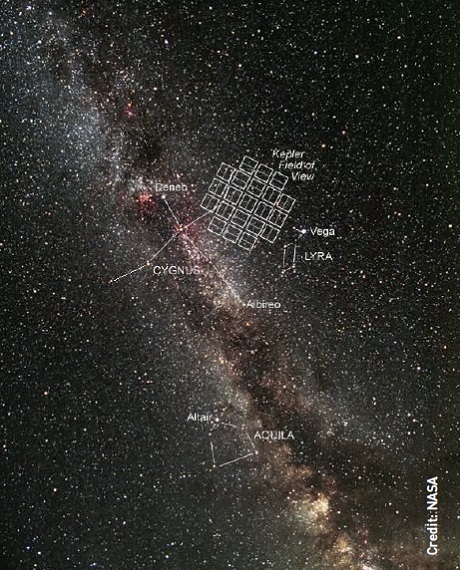 Kepler studied the same starfield in the constellation of Cygnus, so that its target stars could be monitored continuously.
Kepler studied the same starfield in the constellation of Cygnus, so that its target stars could be monitored continuously.
Undoubtedly there are more planets to be found, even smaller than 452b, in the habitable zones of their stars. Just based on 452b and all the other discoveries we can be certain there are many such planets.
The difficult question is – do we have the sensitivity to recover them, given that the stellar variability is higher than we expected it to be? We’ve worked very hard and have made a lot of headway in reducing instrument noise in our light curves. We have more sensitivity than we did two years ago. And significantly more sensitivity than we did even a year ago when we last ran the pipeline.
I have high hopes that we will find a lot of interesting small planets in the habitable zones of Sun-like stars in the next run. Will one of those be Earth’s true twin planet after all?
Even if you assume that Earth-like planets are common, they remain very difficult to detect. The probability of the planet’s orbit being aligned so that a transit takes place is the size of the star divided by the size of the orbit. With planets like Earth orbiting stars like the Sun that gives only have a half percent chance of a transit in the first place.
Coupled with the fact that we still may not have the sensitivity to find all such planets, even the ones that are transiting, and it’s like knowing that there are Christmas presents under the tree. I learned as a child that it’s best not to peek inside the wrapping paper before Christmas Day, it only leads to disappointment. In other words, we will just have to wait and see.





